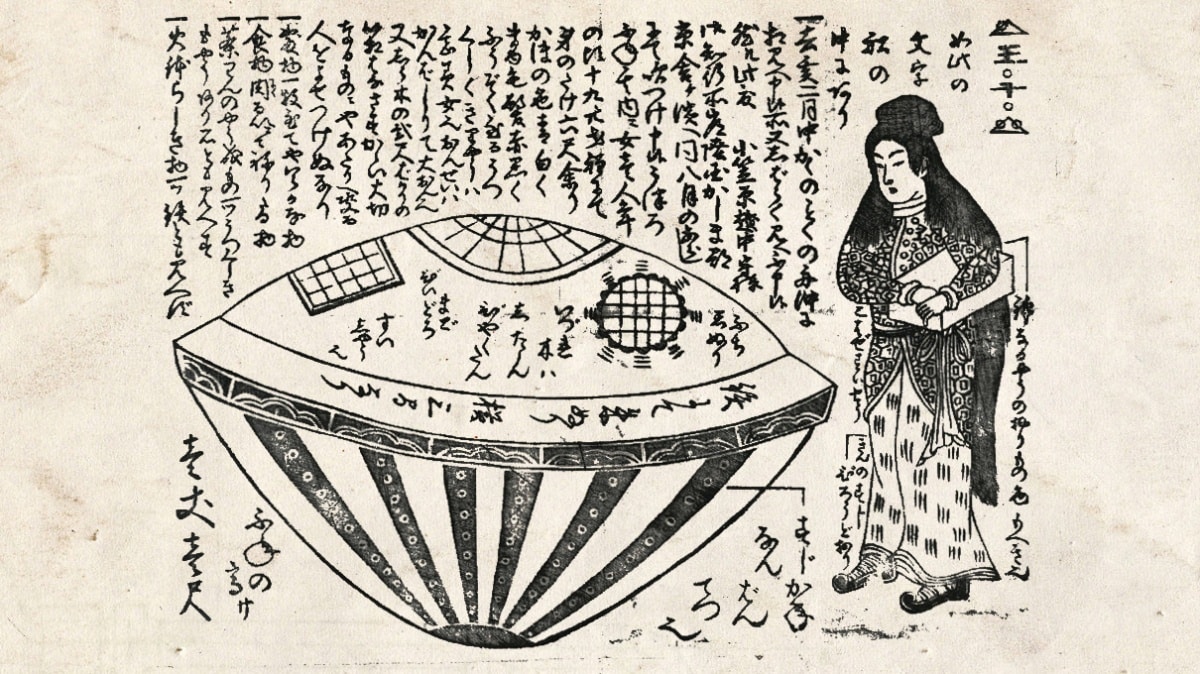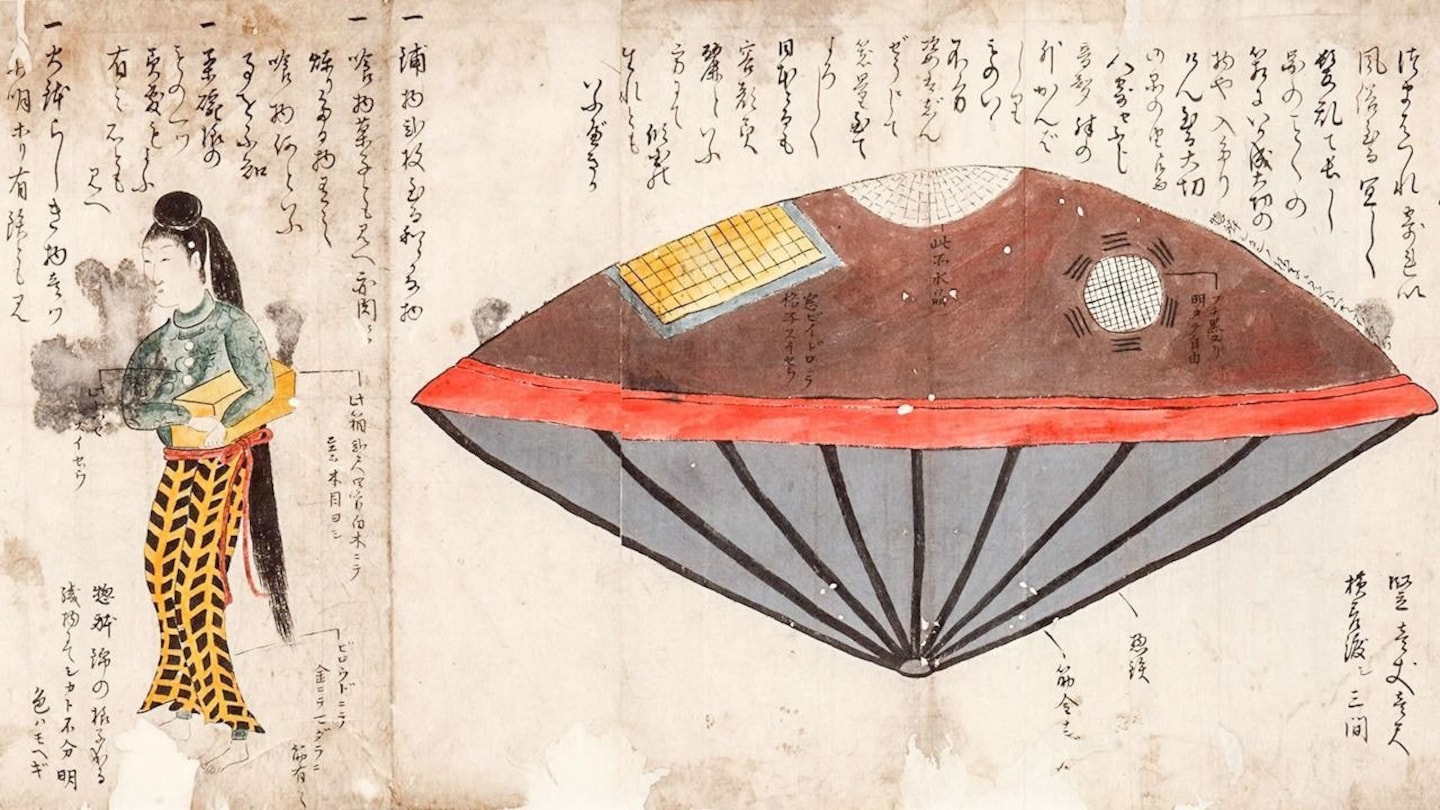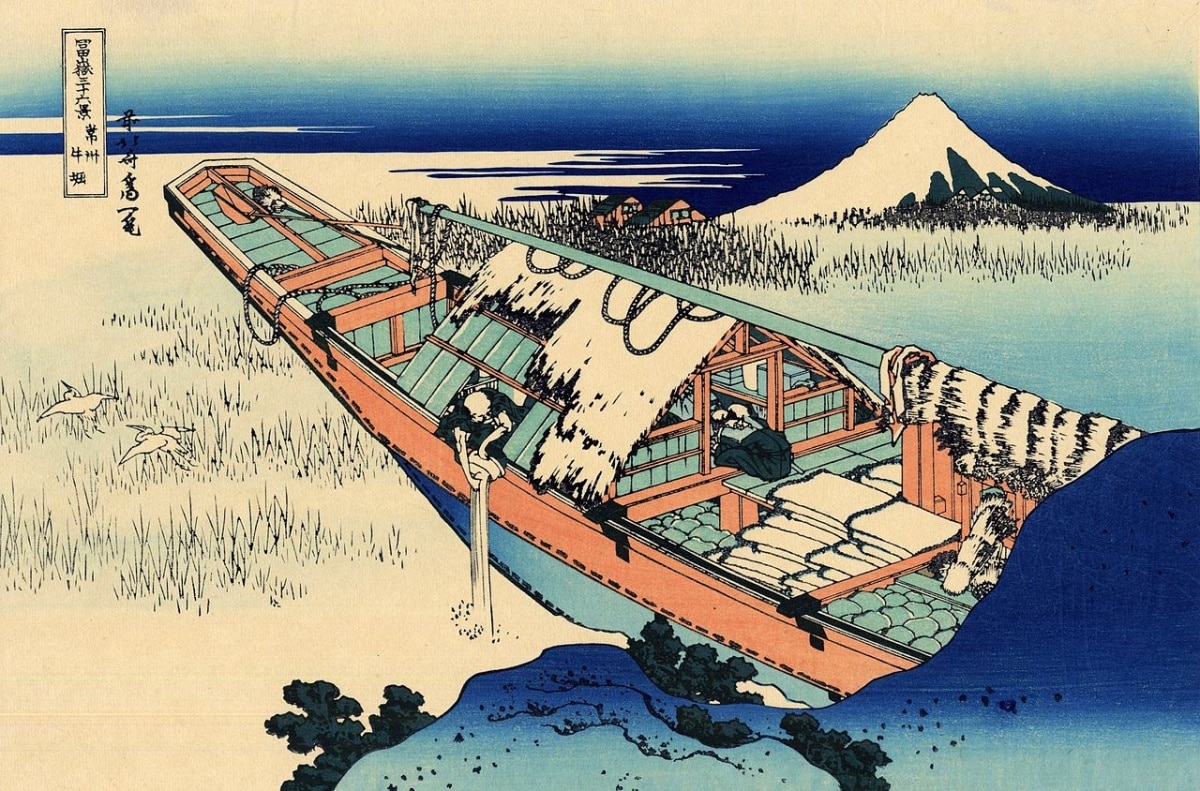Japan’s Ancient UFO: The Tale of Utsuro-bune
Japan’s connection to UFOs is centuries old, and one particular case has perplexed fans and scholars since the Edo period (1603 – 1868). It is the case of the utsuro-bune, or “hollowed ship”.
By David"Several artistic renderings from the era bear striking similarities to the classic depiction of a flying saucer, or UFO."
In recent years, as UFOs have become a subject of proper journalistic and political intrigue, the Japanese legend of the utsuro-bune has resurfaced as a dormant case. "UFO" is, however, in some sense a misnomer, as it was actually a seafaring vessel.
The tale of a strange, hollowed ship found off the coast of what is now Ibaraki Prefecture was described in at least three major 19th-cenutry texts: Toen Shosetsu (1825), Hyoryuki-shu (1835) and Ume-no-chiri (1844) – though scrupulous researchers have discovered mentions in several other documents from earlier in the 1800s.
What has launched the utsuro-bune into the realm of the occult, however, are its unexplained origins and several artistic renderings from the era which bear striking similarities to the classic depiction of a flying saucer, or UFO.
As with most legendary tales, many of the specifics have become submerged in a mire of conflicting accounts under the heavy weight of history. But the tale of the utsuro-bune goes something like this:
(A little artistic licensing has been employed.)
The Tale of the Utsuro-bune (enhanced)

https://en.wikipedia.org/wiki/Utsuro-bune#/media/File:Utsuro-bune.jpg
It’s February of 1803, frigid waves are lapping on the shores of Hitachi Province (modern day Ibaraki Prefecture). A local fishing crew is braving the Pacific Ocean waters in search of a fresh catch for the towns and villages scattering the coastline.
Hauling nets of flopping tuna over the boat’s gunwale onto a salt-sprayed deck, the fisherman are stopped suddenly in their tracks. Something out of the ordinary that is drifting on the water’s choppy surface has caught their eyes.
"What a queer-looking vessel," they confide in one another.
The object in question is approximately 3-by-5 meters and shaped like a piled up rice bowl. The ship is crafted from rosewood, they suspect, or perhaps cedar, with metal coating at its base and windows affixed to the top.
"That is unusual nautical craftsmanship for our times," announces the captain in a brief, and frankly out-of-character, moment of prescience.
Acknowledging that they could all do with a little bit of adventure in their lives, the fisherman jump to oars and head in the direction of the bobbing object. Unable to see clearly through its thick glass top, they knock upon the vessel’s walls and are surprised by the hollow sound.
"Empty?" the captain asks his crew.
"It certainly appears so," one replies. And so they tug it ashore.
"A strange, yet striking woman emerges; hair the color of burnt apricots, skin white as sakura petals, and an elaborate gown made from a fabric unknown."

https://en.wikipedia.org/wiki/Utsuro-bune#/media/File:Utsurofune.jpg
The vessel crunches in the sand of Hitachihara Shirahama beach as the eager fishermen start climbing onboard to see what treasures they may discover. As they approach, however, the top of the vessel pops open with a whump of released pressure. A strange, yet striking woman emerges; hair the color of burnt apricots, skin white as sakura petals, and an elaborate gown made from a fabric unknown.
At first, the fishermen are convinced this damsel is the reincarnation of the bodhisattva statue at nearby Shōfuku-ji Temple. But then she speaks, uttering syllables that bear no resemblance to the Ibaraki dialect. Why would their bodhisattva speak this foreign tongue, they wonder? The woman descends from the top of the boat, holding in her hands a light-colored box which she clearly doesn’t want anyone to touch.
"What is she hiding?" says the captain, as he brushes past her and propels himself onto the vessel.
He peers inside and discovers it’s not entirely hollow after all: a little makeshift homestead replete with supplies and bedding decorates the interior. But it is the unintelligible inscriptions on the wall which demand his attention. The captain, clearly perturbed, scuttles back down the walls of the ship and onto the sodden sand.
At this stage, everybody starts to feel rather unnerved. The woman of the sea is casting accusatory glances at the fishermen staring at her little box. The fisherman share perplexed glances, caught in a predicament.
And so the captain apologises profusely for the behavior of his men, bows the lady adieu and ushers the crew back to their ship with haste.
As the captain takes one last look over his shoulder, he sees the woman has returned to the vessel and is once again drifting out at sea.
The Legend vs The Reality
Upon returning to their villages, the fishermen’s story of the hollowed ship spread far and wide. Who was this woman and what did she want? Was she a banished exile from a distant land? Had she emerged from some place not yet known, or was she merely a Eurasian traveler who had drifted off course?
As an island nation, Japanese folklore is littered with fabled sea-dwelling creatures: the pandemic-prophesizing Amabie (a three-legged birdlike fish), the curse-bringing bake-kujira (ghost whales), and the kappa (the aquatic yokai renowned for its love of cucumbers and sumo). Along with other tales of hollowed ships in Japanese folklore and religious mythology, the utsuro-bune is typically viewed as part of the mythos cannon. What’s to say this strange lady emerging from a hollowed ship isn’t merely another creature of fancy?
But this hasn’t stopped anthropologists, historians, and ultimately ufologists from forming their own conclusions and assumptions.
Professor Kazuo Tanaka of Gifu University, a leading researcher on utsuro-bune legends, told Nippon.com, “[The 1803 utsuro-bune legend] has a number of documents to examine as leads, so . . . for researchers it’s a mystery with substance.”
"A lone, white female traveler landing unexpectedly on their doorsteps would certainly have ignited the imaginations of a provincial fishing crew."

https://pixabay.com/illustrations/landscape-water-rock-spaceship-1328858/
Fans of the occult claim the story and its accompanying sketches are evidence of visitation by extraterrestrial life. As the UFO subject continues to be legitimized, historical sightings--especially one that took place 140 years prior to the catalyst for America’s UFO craze in the 1940s--become more relevant.
Perhaps a more prosaic explanation is that Japan was still half a century from ending its 250-year policy of isolation called sakoku, which completely cut it off from the rest of the world. A lone, white female traveler landing unexpectedly on their doorsteps would certainly have ignited the imaginations of a provincial fishing crew.
That said, during sakoku, reports of a foreign craft landing on Japanese shores would have resulted in a thorough government investigation, of which there is no recorded evidence. It’s also worth noting that there are no records of solo females traversing the Pacific in 1803.
And so, the mystery goes on, as all great unsolved mysteries do. Given the literary proclivity of Edo-period Japan, researchers expect further documentation regarding the utsuro-bune to be discovered in due course. But until then, the explanation of its origins remain in the eye of the beholder.




